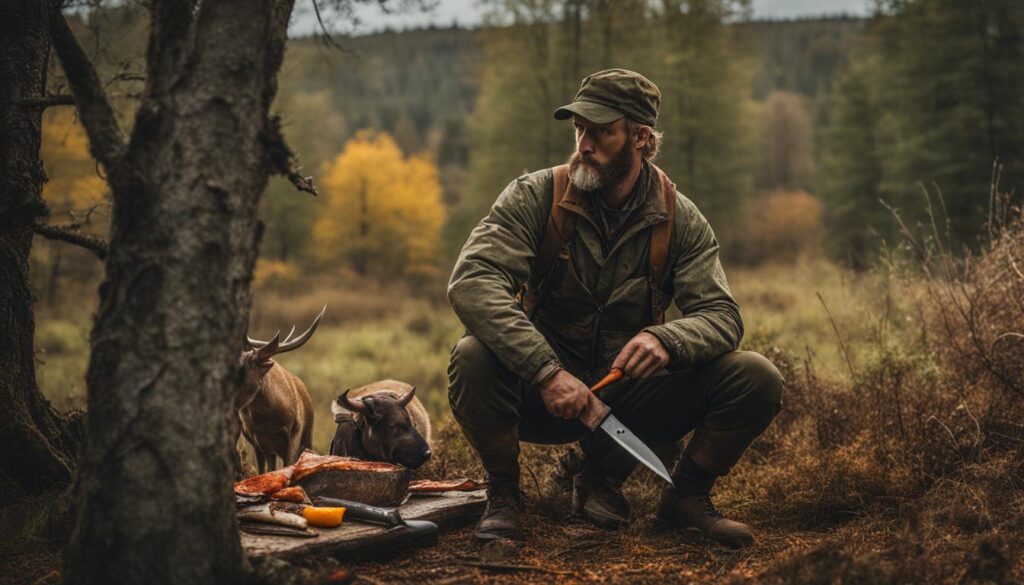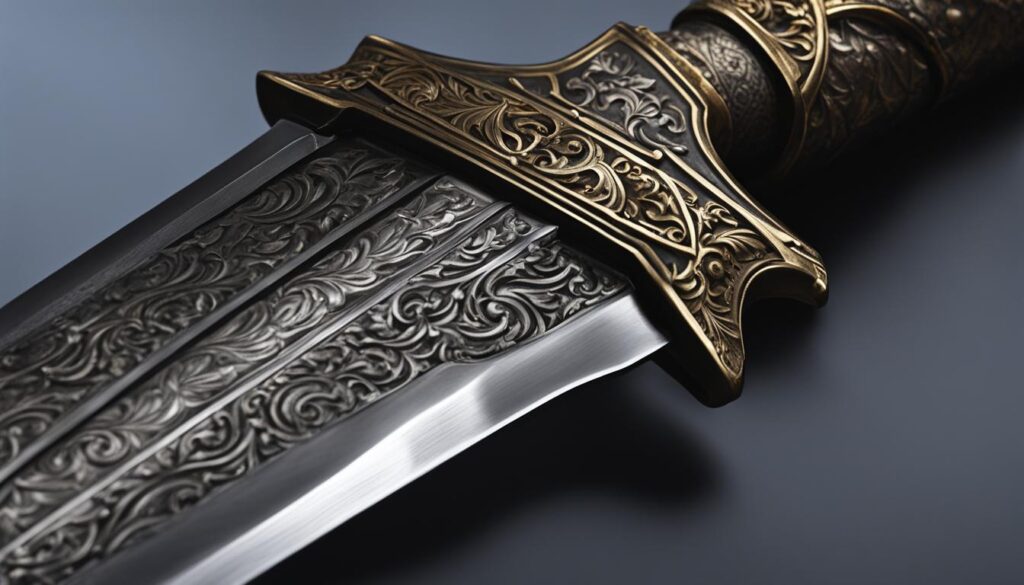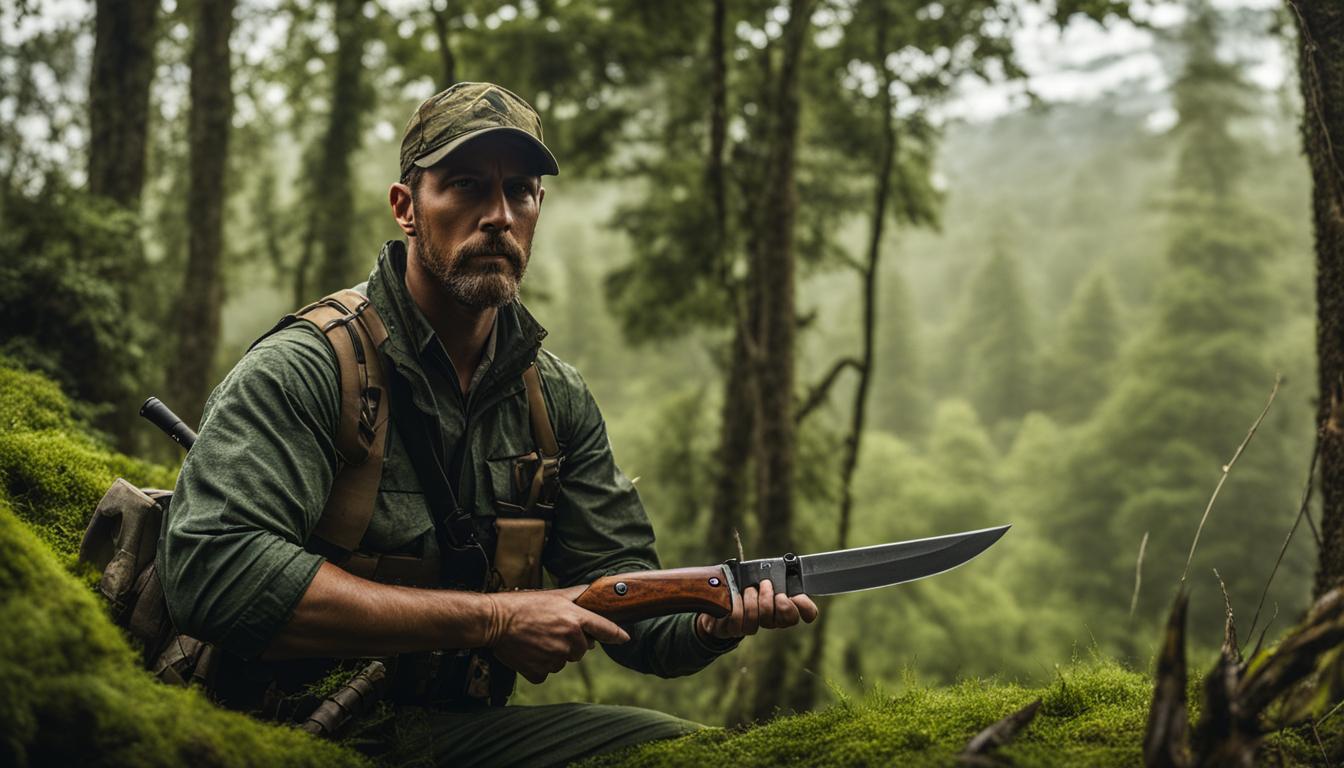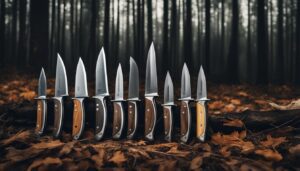As a hunter, I know the importance of having the right tools for the job. One essential gear that every hunter should have in their arsenal is a shorter blade hunting knife. These knives offer a range of advantages that can greatly enhance your hunting experience. Let’s dive into the benefits of shorter blade hunting knives and why they are a must-have for any hunter.
Key Takeaways:
- Shorter blade hunting knives provide increased control, precision, and safety.
- They come in different styles, including camp knives, skinning knives, gutting knives, deboning knives, and hunting daggers.
- Camp knives are versatile and convenient for various tasks around the campsite.
- Skinning knives offer precision in removing an animal’s hide without causing damage.
- Gutting knives are essential for field dressing and preserving the meat.
Versatility and Convenience of Camp Knives
When it comes to versatility in the field, camp knives are a hunter’s best friend. These knives offer a wide range of applications and can handle various tasks with ease. From splitting kindling to preparing meals, camp knives are the go-to tool for all campsite needs.
One of the key advantages of camp knives is their ability to perform multiple functions. They can be used to craft a bow drill for starting fires, cut ropes, clear vegetation, build shelters, and make repairs. Their sturdy construction and sharp blades make them reliable tools for outdoor enthusiasts.
Variety of Camp Knives
There are different styles of camp knives available, including fixed blade and folding pocket knives. Fixed blade camp knives have larger and sturdier drop point blades, making them ideal for heavy-duty tasks. On the other hand, folding pocket knives are more compact and have smaller blades, which are perfect for delicate cuts.
When selecting a camp knife, it’s essential to consider the metal used in its construction. Opt for a knife with a blade made from a metal that resists corrosion and can be easily sharpened. This ensures the longevity and effectiveness of the knife in various outdoor conditions.
To enhance convenience, some hunters choose to carry both a fixed blade camp knife and a folding pocket knife. The combination of these two tools provides versatility, allowing for seamless transitions between different tasks in the field.
Overall, camp knives are indispensable tools for hunters and outdoor enthusiasts. Their versatility, convenience, and reliable performance make them a must-have gear for every campsite adventure.
Precision and Efficiency of Skinning Knives
When it comes to the delicate process of removing an animal’s hide, nothing beats the precision and efficiency of skinning knives. These specialized hunting knives are designed with short, thin blades that are razor sharp, allowing hunters to make precise cuts that minimize damage to the hide. Skinning knives come in various styles and sizes, and hunters can choose one that best suits their needs.
One of the key advantages of skinning knives is their ability to preserve hides or skins for taxidermy purposes. Skinning knives with smaller blades are particularly ideal for this purpose, as they allow hunters to work with intricate details while ensuring minimal damage to the hide. The sharpness and precision of these knives make it easier for hunters to navigate around joints, resulting in cleaner, more professional-looking hides.
Efficiency is another crucial aspect of skinning knives. The sharp and thin blades of these knives allow hunters to make quick and controlled cuts, enabling them to complete the skinning process with ease. Skinning knives are also designed with non-slip handles, providing hunters with maximum control and minimizing the risk of accidents or injuries. In addition, some skinning knives even feature antibacterial properties, ensuring hygiene and preventing the spread of bacteria during the skinning process.
Table: Comparison of Skinning Knives
| Knife Model | Blade Length | Blade Material | Handle Material |
|---|---|---|---|
| Model A | 3.5 inches | Stainless steel | Ergonomic rubber |
| Model B | 4 inches | High carbon steel | Textured polymer |
| Model C | 2.75 inches | Stainless steel | G10 fiberglass |
Table: Comparison of skinning knives showcasing different models, blade lengths, blade materials, and handle materials.
In conclusion, skinning knives are an essential tool for hunters during the skinning process. With their precision, efficiency, and ability to preserve hides, these knives make the skinning process more manageable and professional. Consider the size, blade material, and handle material when selecting a skinning knife to ensure it meets your specific needs in the field.
Effective Field Dressing with Gutting Knives
Gutting knives play a crucial role in the field dressing process, allowing hunters to efficiently remove an animal’s internal organs to preserve the quality of the meat and hide. These knives are specifically designed for this task, with stocky blades and gut hooks that make the process easier and more effective. Field dressing should be done promptly after the animal is killed to prevent spoilage, and gutting knives are essential tools for this important step.
Field dressing not only ensures the preservation of the meat but also reduces the weight of the animal, making it easier to transport out of the field. The sturdy construction of gutting knives provides the necessary strength, while the gut hooks enable hunters to perform precise and controlled cuts. It is important to choose a gutting knife that offers a good grip and is made from durable materials to withstand the demands of field dressing.

| Gutting Knives Features | Benefits |
|---|---|
| Stocky blades with gut hooks | Efficient removal of internal organs |
| Sturdy construction | Provides strength and durability |
| Non-slip handle | Ensures a secure grip during field dressing |
Choosing the right gutting knife is essential for successful field dressing. Look for features that provide efficiency and ease of use, such as a stocky blade with a gut hook and a non-slip handle. It is also important to consider the overall quality and durability of the knife to ensure it can withstand the demands of field dressing. With a reliable gutting knife by your side, you can perform this essential task with precision and efficiency, ensuring that the meat and hide are properly preserved.
Efficient Deboning with Specialized Knives
When it comes to deboning meat, having the right tool is crucial for efficiency and precision. Specialized deboning knives are specifically designed to make this task easier, allowing hunters to remove meat from the bone with ease. These knives have narrow, flexible blades that glide effortlessly along the bones, ensuring minimal wastage and maximum yield.
Deboning knives are available in various styles and sizes, depending on the type of game and personal preference. Some deboning knives are designed to serve dual purposes, functioning as both a boning knife for mammals and a fillet knife for fish, making them versatile tools for hunters who enjoy both land and water hunting.
“Having a specialized deboning knife in your hunting gear is a game-changer. It not only speeds up the deboning process but also allows for cleaner cuts, reducing the risk of leaving valuable meat on the bone,” says veteran hunter John Smith.
Choosing the Right Deboning Knife
When selecting a deboning knife, there are a few factors to consider. Blade material is one of the most important considerations, as it determines the knife’s durability and edge retention. Stainless steel blades are popular for their corrosion resistance, while high-carbon steel blades offer excellent sharpness and edge retention.
Another important factor is the handle of the deboning knife. Look for a handle that provides a comfortable grip and is resistant to slippage, even when wet or slimy. This will ensure optimal control and safety during the deboning process.
Lastly, consider the size and flexibility of the blade. A longer and more flexible blade is generally preferred for larger game, as it allows for deeper cuts and easier maneuverability around bones. However, for smaller game, a shorter and stiffer blade may be more appropriate.
| Blade Material | Handle Material | Blade Length | Flexibility |
|---|---|---|---|
| Stainless Steel | Ergonomic Non-Slip | 6 inches | Flexible |
| High-Carbon Steel | Textured Rubber | 8 inches | Stiff |
| Stainless Steel | Wood | 7 inches | Semi-Flexible |
Table: Comparison of Different Deboning Knife Specifications
Overall, a specialized deboning knife is an essential tool for hunters looking to maximize the yield of their game and simplify the meat processing process. With the right knife in hand, hunters can efficiently debone their harvests and enjoy the rewards of their successful hunts.
The Power of Hunting Daggers


Hunting daggers are a testament to the courage and skill of certain hunters who choose to use them for specific types of game, such as wild boars. These long and sturdy fixed blades are designed to penetrate the armor plate of boars, delivering a fatal blow to the throat or vital organs. The use of hunting daggers requires proper knowledge, expertise, and precision to ensure a quick and ethical kill.
The power of hunting daggers lies in their ability to effectively take down formidable game. Boars, in particular, possess strong defenses that can be challenging to penetrate. The length and strength of hunting daggers allow hunters to overcome these defenses and strike with precision, ensuring a swift and humane kill. It is important, however, for hunters to practice and refine their skills with hunting daggers to ensure the safety of both themselves and the animals they hunt.
Hunting daggers are not commonly used for all types of game but are specifically chosen for their effectiveness in certain hunting scenarios. The use of hunting daggers requires hunters to be in close proximity to their prey, necessitating a higher level of skill, courage, and physical capability. It is crucial for hunters to assess their own abilities and choose the appropriate hunting gear for the specific game they intend to pursue.
Factors to Consider When Choosing a Hunting Knife
When it comes to choosing a hunting knife, there are several key factors to consider that can greatly impact your hunting experience. From blade features to handle materials, selecting the right knife can make a significant difference in your overall performance in the field.
Blade Features
The blade is the most important part of a hunting knife, and different blade types offer distinct advantages. Clip point blades, with their sharp, fine tips, are excellent for piercing and detail work. On the other hand, drop point blades are known for their strength and versatility, making them suitable for a wide range of tasks. Additionally, consider whether you want a hunting knife with a gut hook, which can be valuable for field dressing game. However, keep in mind that gut hooks may be more challenging to sharpen and can easily become clogged with hair.
Handle Materials
The handle of a hunting knife plays a crucial role in providing a secure and comfortable grip. Look for handles made from durable materials such as wood, rubber, or synthetic composites. Ergonomic designs with textured surfaces can enhance grip stability, especially in wet or slippery conditions. Additionally, non-slip handles are essential for maintaining control during precision tasks like skinning and deboning.
Hunting Knife Selection
Choosing between a fixed blade or a folding knife is another important consideration. Fixed blade knives are generally preferred for their strength, reliability, and ease of cleaning. They are also less likely to fail under heavy use. On the other hand, folding knives offer convenience and are easier to carry, making them a popular choice for everyday carry or as a backup tool. However, folding knives may not be as robust as fixed blades and may require more maintenance.
When selecting a hunting knife, it’s important to prioritize your specific needs and preferences. Consider the tasks you’ll be undertaking, the type of game you’ll be hunting, and the conditions you’ll be facing. By carefully evaluating blade features, handle materials, and the overall design, you can find a hunting knife that meets your requirements and enhances your hunting experience.
Conclusion
In conclusion, the benefits of shorter blade hunting knives are vast and undeniable. These knives provide hunters with increased control, precision, and safety in various tasks, making them an essential gear for every hunter.
Shorter blade knives offer versatility and convenience through their different styles, such as camp knives, skinning knives, gutting knives, deboning knives, and hunting daggers. Each style serves a specific purpose and provides unique advantages in the field, allowing hunters to tackle various challenges efficiently.
From camp chores to field dressing and deboning, shorter blade knives prove to be indispensable. They offer precise cuts, efficient meat removal, and the power needed for specific game hunting. When selecting a hunting knife, it is crucial to consider blade features, handle materials, and individual needs to ensure the right tool for a successful hunt.
In summary, shorter blade hunting knives offer unparalleled benefits and play a vital role in a hunter’s toolkit. With their increased control, precision, and versatility, these knives pave the way for a successful and safe hunting experience.
FAQ
What are the benefits of shorter blade hunting knives?
Shorter blade hunting knives offer increased control, precision, and safety for hunters. They are versatile, convenient, and specialized for specific tasks in the field.
What are camp knives used for?
Camp knives are highly versatile and can be used for various tasks around the campsite, including splitting kindling, crafting fire-starting tools, cutting ropes, clearing vegetation, preparing meals, building shelters, and making repairs.
What are skinning knives designed for?
Skinning knives are designed specifically for the delicate process of removing an animal’s hide. They have short, thin blades that need to be razor sharp, allowing for precise cuts that prevent damage to the hide.
Why are gutting knives important for field dressing?
Gutting knives are essential for field dressing, which involves removing an animal’s internal organs to preserve the meat and hide. They have stocky blades with gut hooks that make the process easier and quicker.
What are deboning knives used for?
Deboning knives are used to remove the meat from the animal after it has been gutted and skinned. They have narrow, flexible blades that make the task easier and more efficient.
How are hunting daggers different from other hunting knives?
Hunting daggers are long and sturdy fixed blades that are used for specific game hunting, such as wild boars. They are designed to penetrate the armor plate of boars and deliver a fatal blow to the throat or vital organs.
What factors should be considered when choosing a hunting knife?
When choosing a hunting knife, factors such as blade features, handle materials, and specific needs in the field should be considered. Blade types, including clip point and drop point blades, should also be taken into account.





